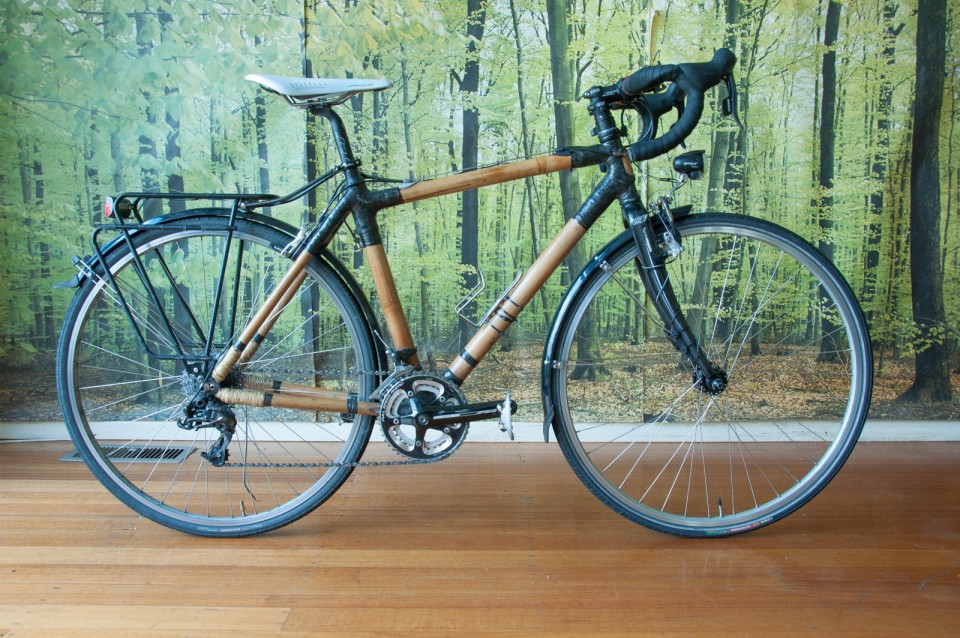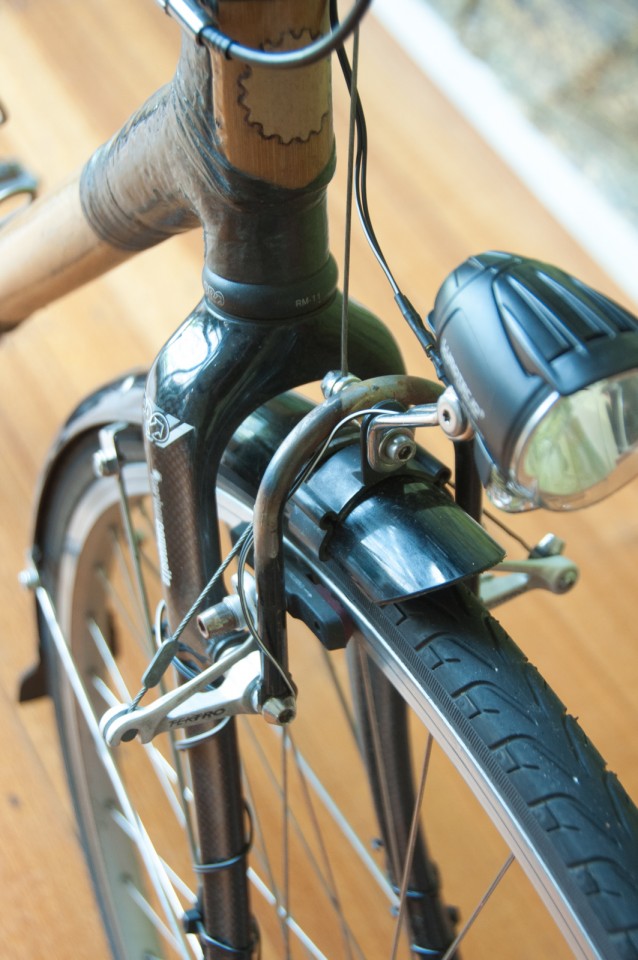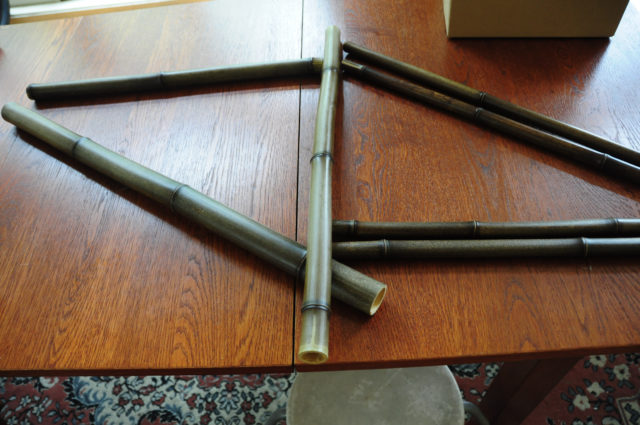The chaps at the Bamboo Bicycle Club in London are demonstrating the power of 3D Printing and bamboo during a Future Bike Live challenge at the Design Museum. Check it out at Kickstarter:
Tag: bamboo
Maisie, 5 years on. A long-term test report.


So it’s been 5 years since I built Maisie, my first bamboo bike, and since then she’s morphed from a svelte single-speed cyclocross machine, to a more relaxed and convenient commuter and tourer. It’s amazing how versatile a bamboo frame is – you can drill holes in it, attach things (like cable-stops) with wood screws, and generally tinker with it without the need for welding. The thick walls mean that threads can actually bite in and using things like rivnuts or threaded inserts is relatively easy.
Last year I got rid of my car, so Maisie’s been my primary mode of transport since then, and I’d estimate I do about 150km per week of commuting and getting about.
I’ve taken a bunch of photos of Maisie in her current state, and will go through the various small customisations that I’ve made in order to turn her into a geared, racked and fendered commuter/tourer.
Cable stops for gears and brakes
Adding gears means adding cables and cable stops. Luckily I’m pretty handy with Solidworks and modelled some nice cable stops which could be screwed onto the frame. I got them 3D printed in nylon and aluminium at Shapeways and then attached them to the frame. The barrel adjuster for the rear derailleur I didn’t make – it’s a standard cable-stop (that would normally affix on some down-tube shifter bosses) that I just drilled a hole through and screwed to the frame.
Fender Mounts
I needed a fender mount near the bottom bracket, but didn’t want to drill another hole in the frame, so I lengthened the derailleur pulley bolt and inserted a spacing washer. The entire assembly is attached by a single bolt from inside the fender, through the spacer, pulley and into a threaded rivnut in the seat-tube. The brake-bridge fender mount was supplied with the fenders, which just fits over the calliper bolt. Standard.
Racking it up
Not much was needed to add a rack to the frame, as the drop-outs already had a mounting bolt hole. All I needed was a Salsa Post Lock seat post clamp and the job was done.
Let there be light
It wouldn’t be a proper commuting bike without a dynamo light, so I bought a new wheel from Commuter Cycles with a SP Dynamo PD-8 in it and wired it up to the top of the line Busch & Muller Lumotec IQ Cyo Senso Plus headlight and a Toplight Line Plus taillight too.
As my fork doesn’t have a crown hole for fenders/lights I mounted it to a u-shaped bracket affixed to the canti-studs. Good mate Scott Symes welded the hourglass to the bracket for me. I should really get around to painting it one day.
It’s absolutely amazing how much a permanent light source changes the way you think about cycling. It’s a total game changer. No more remembering where your USB blinkies are, no having to take them on and off each time you leave your bike locked up somewhere, no having to worry about them going flat. You just get on your bike and ride it, anytime of day or night. Once you get used to this concept it becomes quite a chore to ride a bike without in-built lighting. Viva the light revolution!
How’s she holding up?
Besides some interesting creaking noises when the weather is really hot the frame seems to be maintaining its strength and durability over the long term. There’s been no de-lamination of the carbon, no cracking of the bamboo and despite a few scratches the clear-coat is holding up well. So there’s not much to report on really – it’s a bike, and it still rides like one!
The makings of a cyclocross frame
I’ve recently decided to build a cyclocross frame for the first prototype. I figure if anything’s going to test out the durability of a frame it’ll be a cyclocross race. That and it’s the only sort of bike I don’t own that I’ve always wanted (apart from a recumbent, unicycle, downhill, fixie, penny farthing …).
Here’s how it’s looking so far (ignore the colours, I just like designing in red/black/white):
 As you can see there’s lots of angles, lengths and diameters to figure out. The BikeCAD above only is only showing the basic frame dimensions and angles, not any of the mitre lengths or tubing diameters.
As you can see there’s lots of angles, lengths and diameters to figure out. The BikeCAD above only is only showing the basic frame dimensions and angles, not any of the mitre lengths or tubing diameters.
The main issue to solve with using bamboo is tyre clearance for the chain and seat stays. I’m picturing that the diameter of this bamboo will be slightly larger than a steel/alu/carbon bike in order to get the greatest stiffness. To help overcome the larger than normal tube diameters I’m using a 73mm bottom bracket as well as a wider than normal seat stay attachment angle. If that doesn’t alleviate the problem I’ll try using skinnier bamboo, but fill it with expanding foam filler, which I’ve been told increases stiffness markedly.
The drop outs, bottom bracket, seat tube sleeve and head tube have all been ordered and are on their way. Soon it’ll be mitre time!
Selecting the culms
I’ve selected the 7 culms (fancy word for a bamboo pole) for the first frame. Here’s a pic of them laid out into the respective parts of the frame:
And here’s a view of the thickness of the downtube:
I also ventured to my local hardware store and picked up some epoxy resin, glass coat, borax, beeswax and some other glues and finishes to test the curing and joint making processes with:
I haven’t managed to find Boric Acid anywhere yet thou. I suspect I’ll be able order it online somewhere, or it might be available at a chemist.
The process begins

I’m starting a journey of discovery into 2 things. The way of bamboo and the way of the bike frame. I plan on making 2 prototype bikes with mostly bamboo frames. One with lugged steel joints, the other with woven fibre and epoxy resin. Based on the successes or failures of each prototype I then plan on producing custom frames for demanding customers who’re after something a bit different in their daily ride.
The prototype bikes are going to be simple single-speed flat-bar commuters, similar in geometry and style to a Giant CRX or Apollo Blade.
Using BikeCAD and a tape measure I’ll measure and design the requirements for each frame, and decide upon what’s going to be bamboo, and what’s best left to steel or other material.
I’ve sourced enough bamboo (from my kind parent’s garden) for two bikes. But before I can use it I need to cure and treat it against bugs, mould and cracking. Hopefully I’ve got enough to play with after all the experimenting!

After treating the bamboo I’ll be examining diameters to see which will best suit the various parts of the frames. From there I’ll explore the joining process with metals and other materials.
Protecting the bamboo against the elements will also require some research. What oils, paints or varnishes can I use?
This site will seek to be a resource of information about bamboo bikes as well as a documentation of the building process from start to finish for others to follow.










